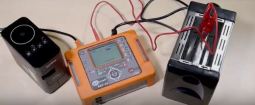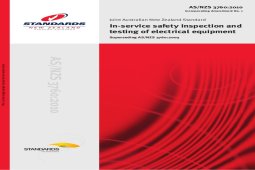
Electrical calibration, in a nutshell, is a process of verifying an instrument’s accuracy. By default, every instrument that leaves the manufacturing plant is calibrated and certified based on recognised standards.
So why the need to calibrate, you might ask?
As with most devices, the components in your electrical testing instrument may shift over time. The shift may be small and insignificant, but in some cases it may cause a slight difference in measurement. The components are more likely to shift or get damaged if your instrument was accidentally dropped or hit against a hard surface. Your instrument might still work after such events, but you can’t be sure that it will still give you precise results. Calibrating your device gives you quantifiable confidence in its measurement accuracy and performance.
Calibration is especially important in cases where you are working with tight tolerances wherein proper operation of safety systems and processes requires accurate measurement. For instance, when testing Class II appliances where you’re working with small values, a minute discrepancy in the results could pass an item that should be failing, and vice versa. Or when you are trending data, and the meters you use for the same test produce different results. As far as electrical safety goes, using a less accurate electrical test instrument presents a number of risks and legal repercussions.
Electrical calibration
Technically speaking, electrical calibration is a process of verifying and/or adjusting the performance of any instrument used to test or measure electrical parameters (i.e. voltage, current, resistance, etc.).
Some people mistakenly call two meters “calibrated” if they both give the same reading during a field comparison check. But this does not necessarily prove that the two meters are accurate – they could both be “out of cal” condition by the same amount. A simple field check does not reveal the real condition of your electrical testing device. There must be a known standard to which the instrument is tested.
You can send your electrical test equipment to an accredited metrology lab or calibration specialist like Metrotest, who will check your testing equipment’s performance and key properties using precision devices that are at least 10 times more accurate than the unit under test (UUT).
Sending your device for calibration essentially means that you are authorizing the calibration house to carry out repairs or correction to bring the device back to “in cal” condition.
You’ll receive a report showing how your instrument compares to recognized standards, what errors were found and what corrections were done.
Calibration procedures
Calibrating your test instrument is a given, so the real question here is how often you should calibrate your tools. This will depend on the brand you’re using and how well the device is handled.
Sonel

For new devices with calibration certificate, Sonel recommends the next metrological inspection within 13 months from the purchase date, and not later than 19 months from the manufacturing date. Pursuant to standard EN ISO 10012-2003, a 13-months interval for testing must be observed.
Sonel calibration includes voltage, current and resistance calibration for instruments used for electrical and non-electrical measurements, including:
- Electrical safety meters
- Multimeters
- Meters for electrical protective measurements: earthing resistances, insulation resistance, impedance and resistance of short-circuit loops, RCD parameters, etc.
- Meters for measuring low resistance values
- Power quality anlysers
Metrel

With the exception of digital mutimeters, current clamps and voltage testers, every Metrel device gets an ISO certificate when it leaves the production floor. Metrel’s default calibration includes installation testers (e.g. Eurotest, Instaltest, Insulation test), test equipme
nt (e.g. Clampmeters, Resistors, Multimeters), safety appliance testers (e.g. PAT, CE Multitester), and test equipment for environmental conditions (e.g FonS, Multinorm).
Calibration services will include adjustment, that is, bringing the instrument into a state of performance that is suitable for its use. All procedures are written a guarantee of reliability and repeatability of measurements. Metrel does not accept calibration request from end users, so you’ll need to send your device to an accredited metrology lab.
Megger

Megger tester calibration includes resistance function verification and voltage function verification. The procedure measures a resistance by generating a voltage. The value of resistance is computed using Ohms Law: V=IR. Megger has its own calibration box which is used to provide an analog resistance for the unit under test (UUT). The resistance output and voltage display of the calibration box is compared to that of the UUT’s.
Calibration can also be done using a Fluke multimeter as a reference standard. This gives measurement data on the entire range of your Megger.
Seaward
Seaward has a Tool Tester Checkbox that is designed to make calibration safe, simple and quick. It allows regular calibration to be a part of your safety programme. Seaward PAT testers are recommended for calibration on an annual basis. But for low-usage instruments, calibration interval may be extended under certain conditions, i.e. if the test equipment are regularly checked using the Checkbox and there is no deviation in performance.
CEM

All electrical testers are required to have annual calibration. While you can use a calibration checkbox to ensure the continuous accuracy of your CEM device, it does not equal a full in-house calibration which tests tolerances and full instrument ranges in a controlled environment to ensure the manufacturer specifications are met. At Metrotest, we use traceable standards for our calibration services and we issue a detailed certificate outlining all value obtained under calibration.
Aegis
The Aegis PATROL tester has inbuilt functional test features and a recommended manual procedure that must be performed regularly for self-checking the correct operation of the device. The PATROL performs a Self Check on power up and before each test sequence. In addition to these functional tests, Aegis recommends that your tester must still be sent for calibration every 12 months at minimum. If your device is used under harsh environments or is mishandled, the timeframe must be shortened to ensure it operation at peak performance.
Trio

Specifically for the Trio SafeTCheck PAT tester, the routine calibration interval is 12 months. It is recommended that all data is downloaded prior to sending your instrument for calibration, as some data may be lost during the process. The calibration is usually no different from other manufacturers’ testers, and will take anywhere from 2 to 5 days to ensure all results are correct.
Wavecom

Wavecom testers are typically supplied with a calibration certificate valid for 12 months. The manufacturer recommends an annual routine calibration or verification of instruments as prescribed under the AS/NZS 3760:2010 Standard. This must be done only by Wavecome Instruments or by authorised service agents.
During calibration, your PAT tester is checked to ensure operation within certain tolerances. Multiple checks are made are different ‘reference points.’ Depending on the results, your device may or may not need adjustment or repair. The operating firmware may be updated and the calibration settings may be changed.
Kyoritsu

Re-calibration can be done by Kyoritsu, your distributor or an approved calibration house. At Metrotest, our qualified technicians can calibrate and adjust your Kyoritsu PAT tester to all relevant manufacturer and safety standards. We will issue a detailed calibration certificate traceable to national and international standards. Please check that your instrument does not have any structural abnormality prior to sending it for a metrological test.
Calibration is a form of quality and safety assurance, which allows you to use your electrical test equipment with confidence.
For more information, please contact us on 0800 638 768 (NZ) /1800 789 973 (AU) or drop us a line to [email protected].











